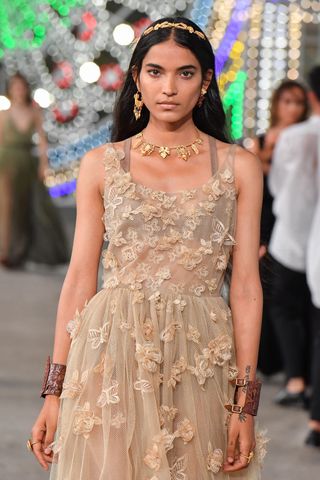For Dior’s artistic director Maria Grazia Chiuri, the lockdown was a time for reflection on everything from sustainability to the renewed importance of craft (something she showcased in the house’s artisan-centric cruise show in July.) As part of ELLE’s examination of the future of fashion, the designer shared her thoughts on the «shameful wastefulness» she thinks the industry needs to leave behind in this new era.
The conversation around fashion pre-COVID was focused on making the industry more sustainable, both environmentally and in terms of pace. Do you think the current crisis has accelerated those conversations? Do you think it will ultimately push the industry in a more sustainable direction?
I think so and I hope so. This health crisis has forced us to confront several limitations of the production model that we work within–limitations linked to environmental but also human sustainability. We all found ourselves with a lot of time on our hands to think, which is something that was sorely lacking in our lives before. Time to think about what we do, how we do it, and what price we pay for our working arrangements, both in material terms but also related to creativity. Fortunately, this quickly led to a heightened awareness of the critical issues we are faced with.
How are the current limitations forcing everyone to be more creative? Have you been reimagining the way you do things?
I’m not sure we can talk about “more” or “less” creativity. Creativity is not a quantity that increases or decreases; it’s a strange animal. It develops in ways that escape all rationale. As with instinct, creativity is surely influenced by whatever is going on around us. Recent changes in our routines have had an effect on how we approach our projects, and also on the issues that we are drawn to the most, the issues that incite us to produce something that is culturally relevant and responds to current needs. This is reflected in how we work in teams, how debates take place and ideas are exchanged, which naturally leads to how these ideas are translated into material objects. It’s a new normal, but it’s great to be back together to look for solutions for working together, with such enthusiasm and good will.
This period has given everyone time to reflect—what have you learned over the last few months that will influence your work (or that you feel will influence the industry) going forward? Do think there will be a renewed appreciation for craft/quality?
It’s difficult to make predictions; we don’t yet have enough hindsight to assess things critically. What we can do is rise to the occasion, take up the current challenge, and work within the guidelines designed to safeguard our health. I really hope that the attention to quality and the return to delighting in details, in craftsmanship, in the beauty of objects in general–aesthetic and in production–will be the long-term silver lining of the months of solitude and reflection we have just experienced.
How do you think fashion shows and fashion weeks could change? Are there other traditional ways of operating that you think will change? What do you envision taking their place? How can fashion transform and become a stronger industry?
There is no doubt that many things will change, especially how people and things get around, and how often we are asked to show our work. At least for now. But slowing down right now does not mean denying the value of fashion, nor does it mean missing out on anything. That goes for clothes and objects in general, but also for their corollaries like fashion shows, presentations, editorials and exhibitions that go hand in hand with fashion. A more mindful relationship with time and a more direct connection with what people want and need: that’s what it will take for the fashion industry to keep its relevance in society and consolidate its role as a touchstone of contemporary culture.
What do you want to take away from this time, and what do you want to leave behind in the pre-COVID era?
Shameful wastefulness. Political claims that become a mere PR act. Abstentionism and turning a blind eye to the problems we face today.
A lot has been said about what people are wearing at home, but what overall changes have you noticed in how people are dressing? Do you foresee a point when the pendulum will shift and people will be excited to dress up again?
History has taught us that people’s tastes fluctuate with time, depending on what is happening in the world. And these fluctuations occur more as “reactions” to the status quo than as a natural progression. That is why, yes, I expect–and even hope a little–that we will quickly go back to expressing joy and enthusiasm through fashion choices that are daring and mindful. A celebration of joy in seeing, ultimately, the full picture of oneself.
Read More On The Future of Fashion
This content is created and maintained by a third party, and imported onto this page to help users provide their email addresses. You may be able to find more information about this and similar content at piano.io









